Summative Assessment: Professional Development Plan Report Analysis
VerifiedAdded on 2023/01/03
|9
|1989
|75
Report
AI Summary
This report is a comprehensive Personal Development Plan (PDP) that begins with a reflective analysis of the student's learning experiences. Part A focuses on self-assessment, highlighting strengths such as strong written communication, organizational skills, and motivational abilities, while acknowledging weaknesses in oral communication, time management, and leadership. The student outlines strategies to leverage strengths and address weaknesses, including participation in online sessions for oral communication, prioritizing tasks for better time management, and reading biographies of leaders. Part B presents a detailed PDP, utilizing SWOT analysis to identify opportunities and threats in the professional landscape, followed by the application of the SMART technique to set specific, measurable, achievable, realistic, and timely goals. These goals include improving oral communication, enhancing time management skills, and developing leadership abilities, with corresponding short, medium, and long-term objectives. The report concludes by summarizing the process of self-assessment and goal setting, emphasizing the importance of reflective practice and structured planning for personal and professional development, with the aim of achieving career objectives. This report is available on Desklib, a platform providing past papers and solved assignments to students.
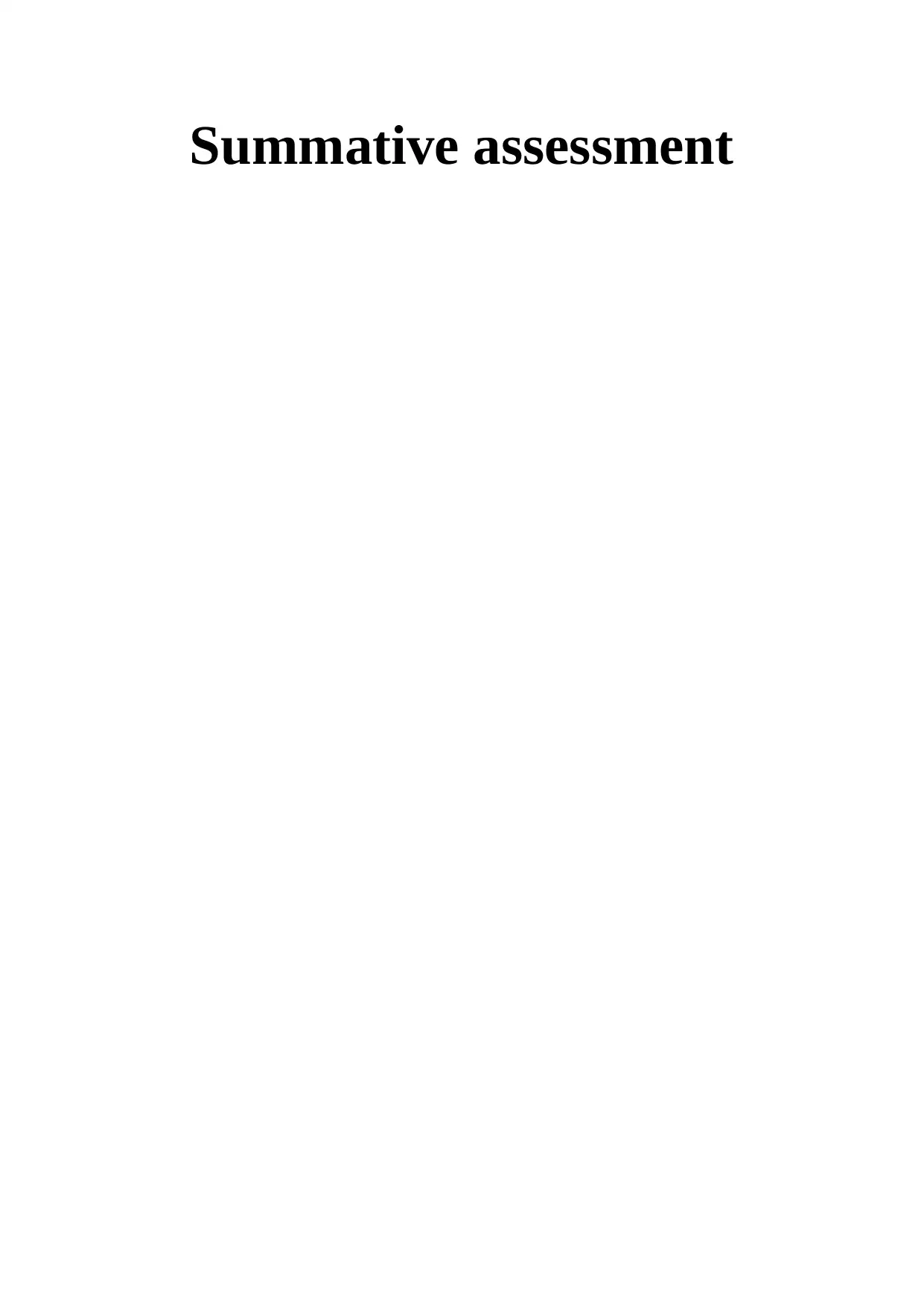
Summative assessment
Paraphrase This Document
Need a fresh take? Get an instant paraphrase of this document with our AI Paraphraser
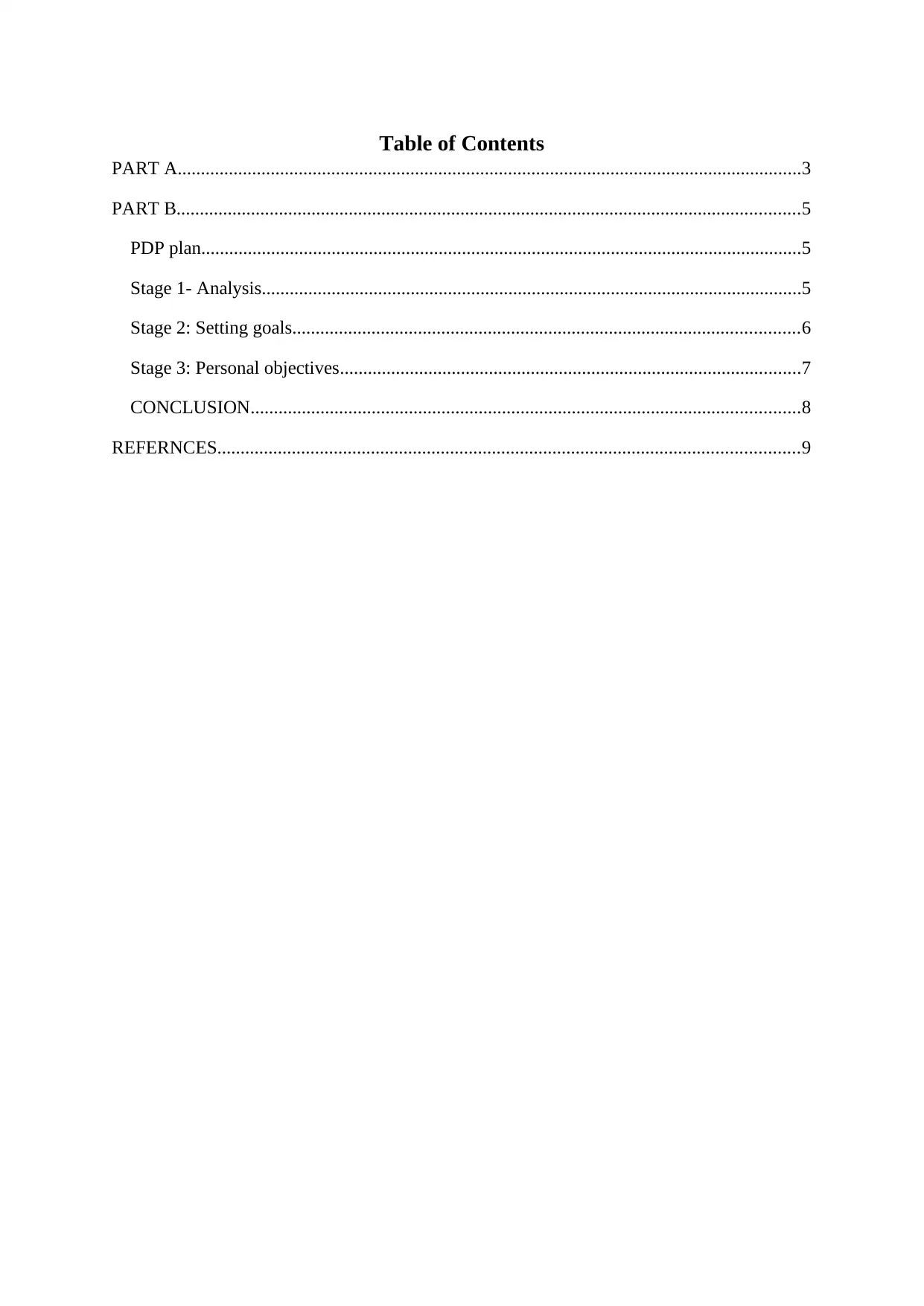
Table of Contents
PART A......................................................................................................................................3
PART B......................................................................................................................................5
PDP plan.................................................................................................................................5
Stage 1- Analysis....................................................................................................................5
Stage 2: Setting goals.............................................................................................................6
Stage 3: Personal objectives...................................................................................................7
CONCLUSION......................................................................................................................8
REFERNCES.............................................................................................................................9
PART A......................................................................................................................................3
PART B......................................................................................................................................5
PDP plan.................................................................................................................................5
Stage 1- Analysis....................................................................................................................5
Stage 2: Setting goals.............................................................................................................6
Stage 3: Personal objectives...................................................................................................7
CONCLUSION......................................................................................................................8
REFERNCES.............................................................................................................................9
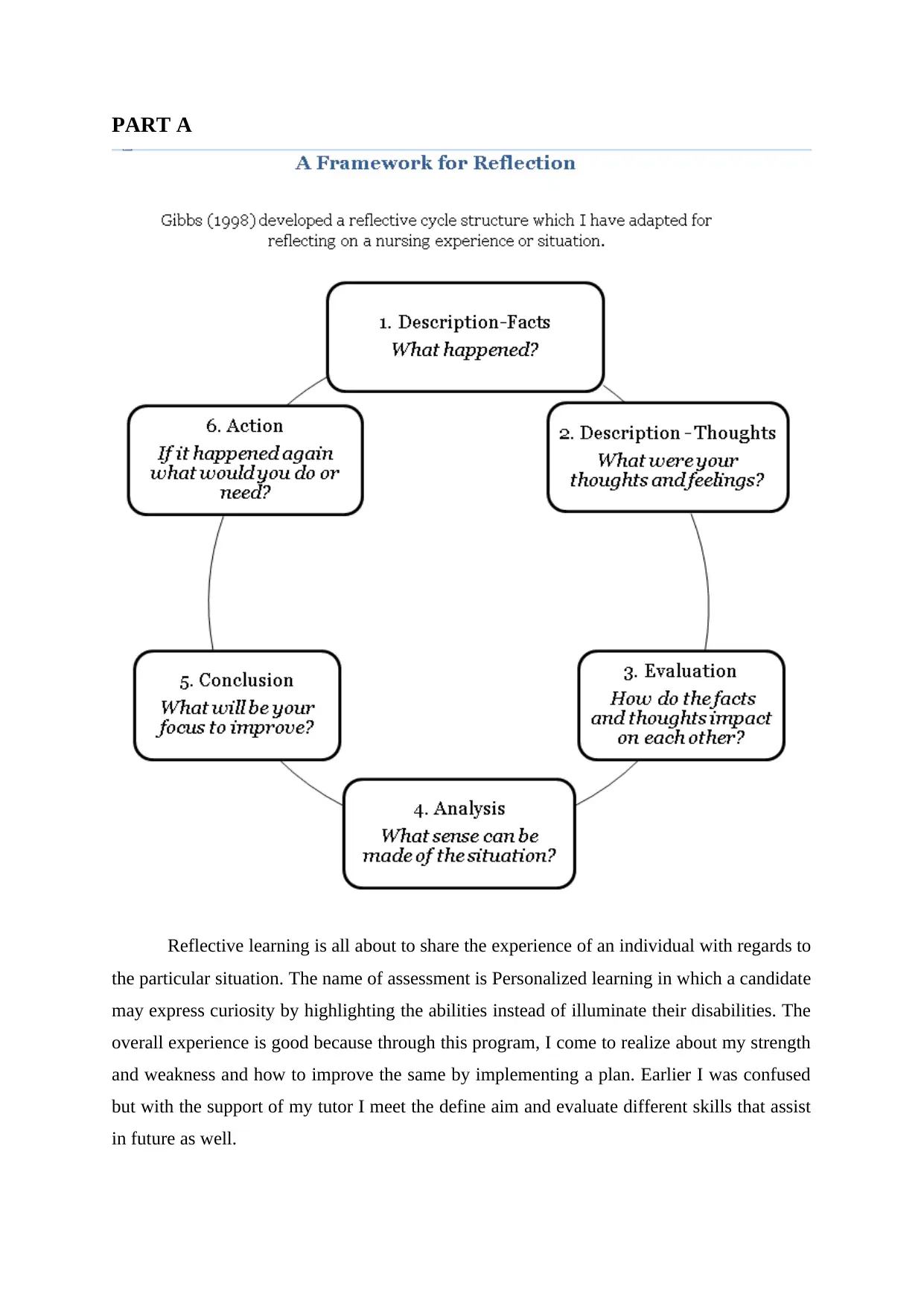
PART A
Reflective learning is all about to share the experience of an individual with regards to
the particular situation. The name of assessment is Personalized learning in which a candidate
may express curiosity by highlighting the abilities instead of illuminate their disabilities. The
overall experience is good because through this program, I come to realize about my strength
and weakness and how to improve the same by implementing a plan. Earlier I was confused
but with the support of my tutor I meet the define aim and evaluate different skills that assist
in future as well.
Reflective learning is all about to share the experience of an individual with regards to
the particular situation. The name of assessment is Personalized learning in which a candidate
may express curiosity by highlighting the abilities instead of illuminate their disabilities. The
overall experience is good because through this program, I come to realize about my strength
and weakness and how to improve the same by implementing a plan. Earlier I was confused
but with the support of my tutor I meet the define aim and evaluate different skills that assist
in future as well.
⊘ This is a preview!⊘
Do you want full access?
Subscribe today to unlock all pages.

Trusted by 1+ million students worldwide
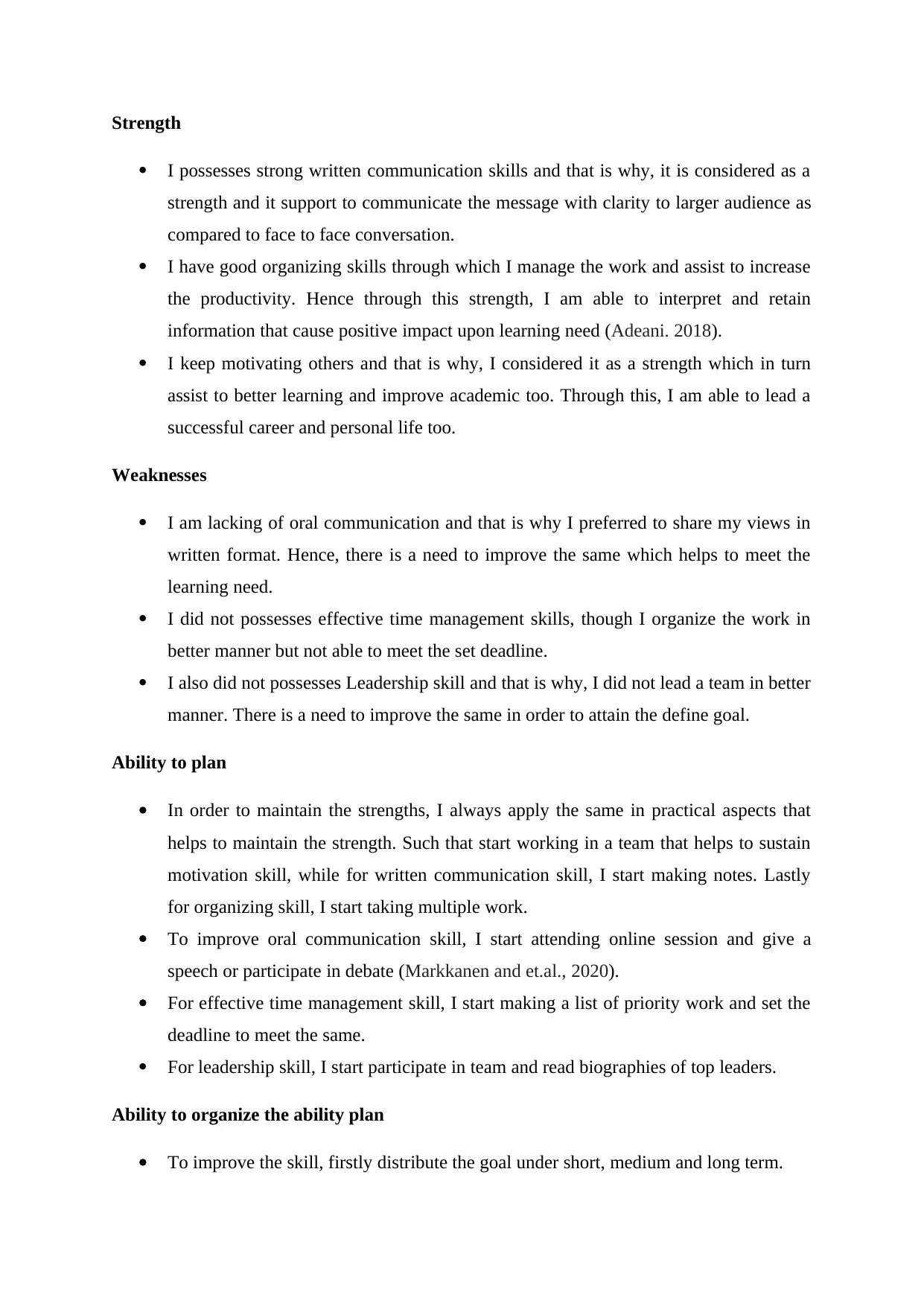
Strength
I possesses strong written communication skills and that is why, it is considered as a
strength and it support to communicate the message with clarity to larger audience as
compared to face to face conversation.
I have good organizing skills through which I manage the work and assist to increase
the productivity. Hence through this strength, I am able to interpret and retain
information that cause positive impact upon learning need (Adeani. 2018).
I keep motivating others and that is why, I considered it as a strength which in turn
assist to better learning and improve academic too. Through this, I am able to lead a
successful career and personal life too.
Weaknesses
I am lacking of oral communication and that is why I preferred to share my views in
written format. Hence, there is a need to improve the same which helps to meet the
learning need.
I did not possesses effective time management skills, though I organize the work in
better manner but not able to meet the set deadline.
I also did not possesses Leadership skill and that is why, I did not lead a team in better
manner. There is a need to improve the same in order to attain the define goal.
Ability to plan
In order to maintain the strengths, I always apply the same in practical aspects that
helps to maintain the strength. Such that start working in a team that helps to sustain
motivation skill, while for written communication skill, I start making notes. Lastly
for organizing skill, I start taking multiple work.
To improve oral communication skill, I start attending online session and give a
speech or participate in debate (Markkanen and et.al., 2020).
For effective time management skill, I start making a list of priority work and set the
deadline to meet the same.
For leadership skill, I start participate in team and read biographies of top leaders.
Ability to organize the ability plan
To improve the skill, firstly distribute the goal under short, medium and long term.
I possesses strong written communication skills and that is why, it is considered as a
strength and it support to communicate the message with clarity to larger audience as
compared to face to face conversation.
I have good organizing skills through which I manage the work and assist to increase
the productivity. Hence through this strength, I am able to interpret and retain
information that cause positive impact upon learning need (Adeani. 2018).
I keep motivating others and that is why, I considered it as a strength which in turn
assist to better learning and improve academic too. Through this, I am able to lead a
successful career and personal life too.
Weaknesses
I am lacking of oral communication and that is why I preferred to share my views in
written format. Hence, there is a need to improve the same which helps to meet the
learning need.
I did not possesses effective time management skills, though I organize the work in
better manner but not able to meet the set deadline.
I also did not possesses Leadership skill and that is why, I did not lead a team in better
manner. There is a need to improve the same in order to attain the define goal.
Ability to plan
In order to maintain the strengths, I always apply the same in practical aspects that
helps to maintain the strength. Such that start working in a team that helps to sustain
motivation skill, while for written communication skill, I start making notes. Lastly
for organizing skill, I start taking multiple work.
To improve oral communication skill, I start attending online session and give a
speech or participate in debate (Markkanen and et.al., 2020).
For effective time management skill, I start making a list of priority work and set the
deadline to meet the same.
For leadership skill, I start participate in team and read biographies of top leaders.
Ability to organize the ability plan
To improve the skill, firstly distribute the goal under short, medium and long term.
Paraphrase This Document
Need a fresh take? Get an instant paraphrase of this document with our AI Paraphraser
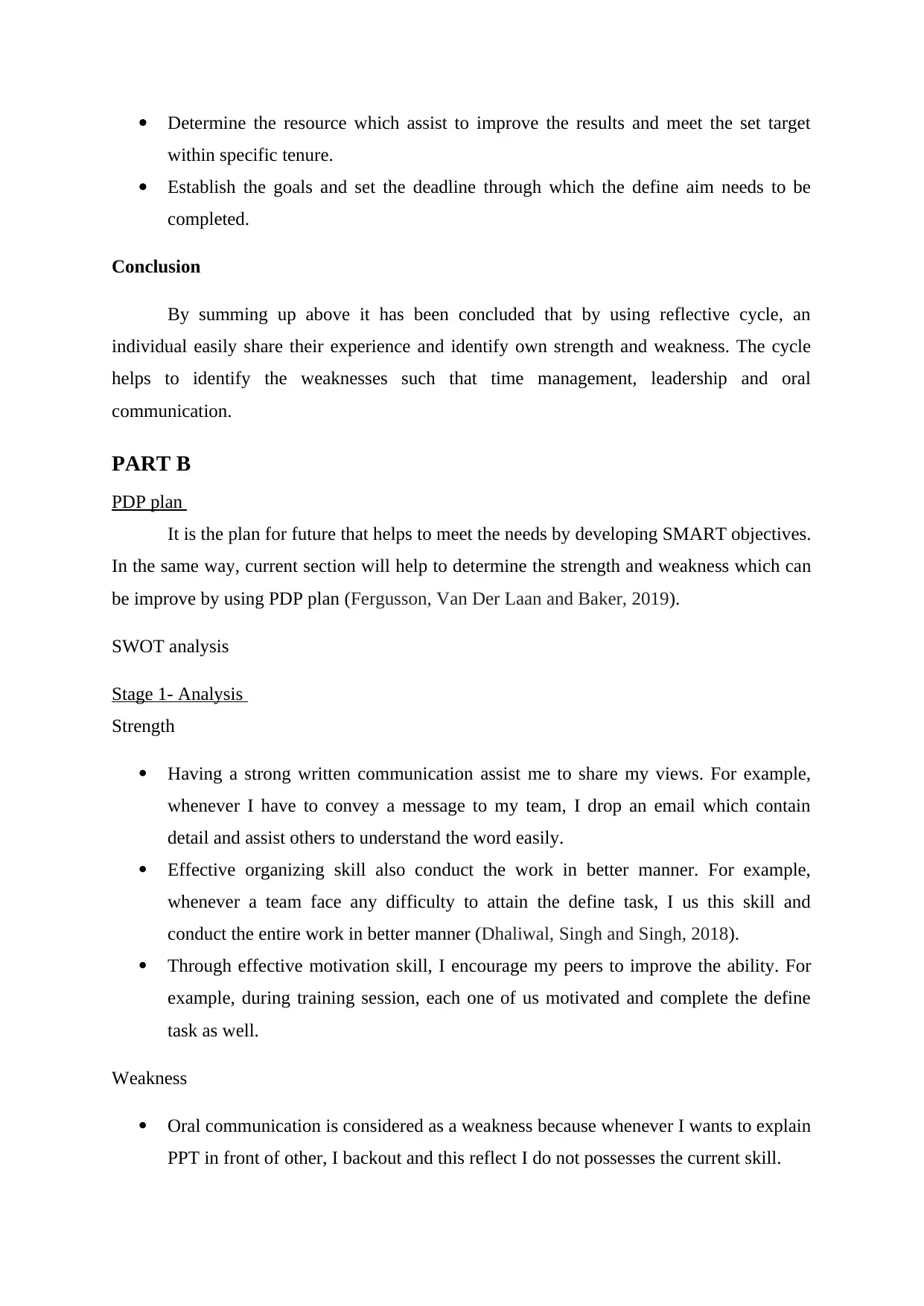
Determine the resource which assist to improve the results and meet the set target
within specific tenure.
Establish the goals and set the deadline through which the define aim needs to be
completed.
Conclusion
By summing up above it has been concluded that by using reflective cycle, an
individual easily share their experience and identify own strength and weakness. The cycle
helps to identify the weaknesses such that time management, leadership and oral
communication.
PART B
PDP plan
It is the plan for future that helps to meet the needs by developing SMART objectives.
In the same way, current section will help to determine the strength and weakness which can
be improve by using PDP plan (Fergusson, Van Der Laan and Baker, 2019).
SWOT analysis
Stage 1- Analysis
Strength
Having a strong written communication assist me to share my views. For example,
whenever I have to convey a message to my team, I drop an email which contain
detail and assist others to understand the word easily.
Effective organizing skill also conduct the work in better manner. For example,
whenever a team face any difficulty to attain the define task, I us this skill and
conduct the entire work in better manner (Dhaliwal, Singh and Singh, 2018).
Through effective motivation skill, I encourage my peers to improve the ability. For
example, during training session, each one of us motivated and complete the define
task as well.
Weakness
Oral communication is considered as a weakness because whenever I wants to explain
PPT in front of other, I backout and this reflect I do not possesses the current skill.
within specific tenure.
Establish the goals and set the deadline through which the define aim needs to be
completed.
Conclusion
By summing up above it has been concluded that by using reflective cycle, an
individual easily share their experience and identify own strength and weakness. The cycle
helps to identify the weaknesses such that time management, leadership and oral
communication.
PART B
PDP plan
It is the plan for future that helps to meet the needs by developing SMART objectives.
In the same way, current section will help to determine the strength and weakness which can
be improve by using PDP plan (Fergusson, Van Der Laan and Baker, 2019).
SWOT analysis
Stage 1- Analysis
Strength
Having a strong written communication assist me to share my views. For example,
whenever I have to convey a message to my team, I drop an email which contain
detail and assist others to understand the word easily.
Effective organizing skill also conduct the work in better manner. For example,
whenever a team face any difficulty to attain the define task, I us this skill and
conduct the entire work in better manner (Dhaliwal, Singh and Singh, 2018).
Through effective motivation skill, I encourage my peers to improve the ability. For
example, during training session, each one of us motivated and complete the define
task as well.
Weakness
Oral communication is considered as a weakness because whenever I wants to explain
PPT in front of other, I backout and this reflect I do not possesses the current skill.
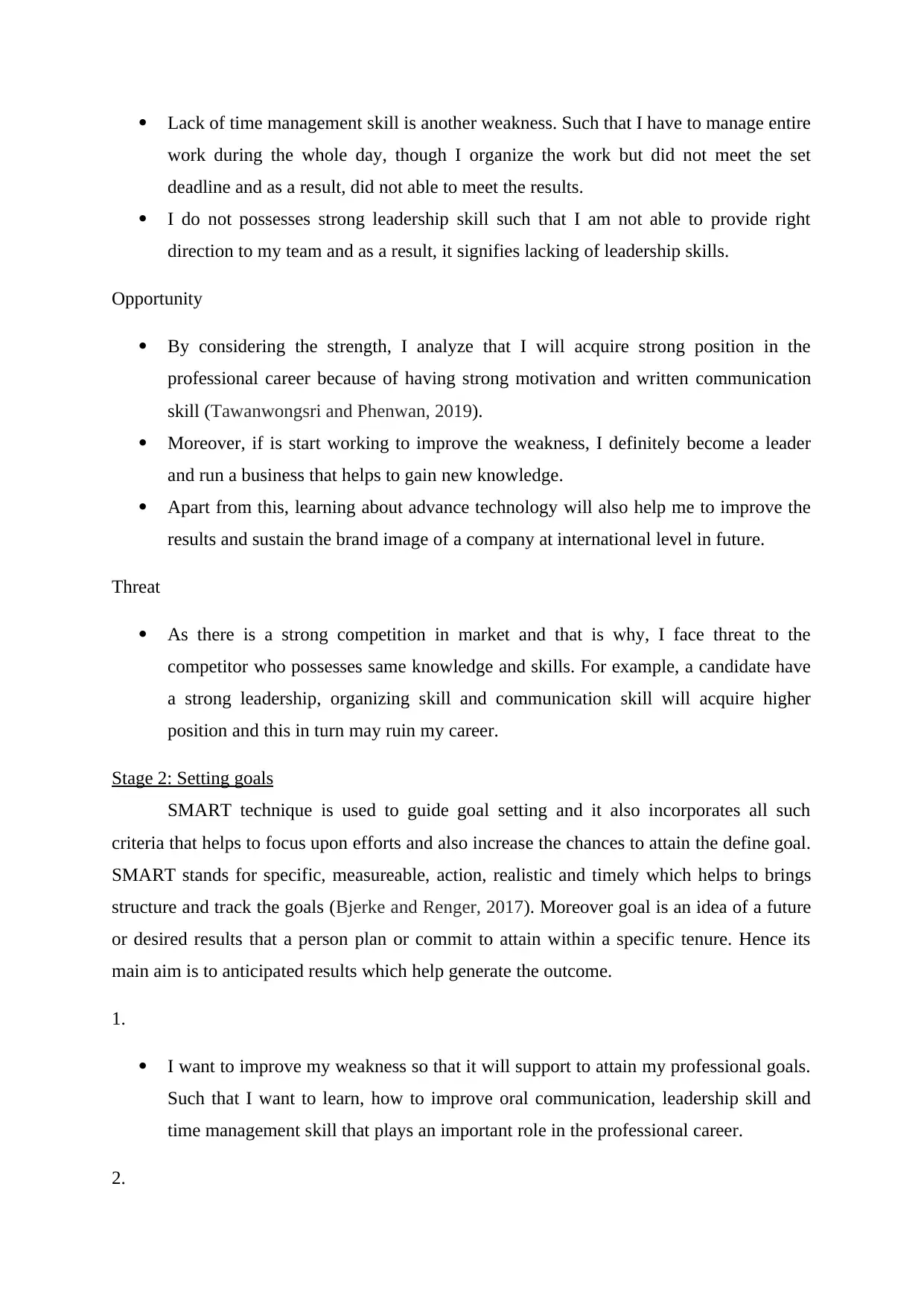
Lack of time management skill is another weakness. Such that I have to manage entire
work during the whole day, though I organize the work but did not meet the set
deadline and as a result, did not able to meet the results.
I do not possesses strong leadership skill such that I am not able to provide right
direction to my team and as a result, it signifies lacking of leadership skills.
Opportunity
By considering the strength, I analyze that I will acquire strong position in the
professional career because of having strong motivation and written communication
skill (Tawanwongsri and Phenwan, 2019).
Moreover, if is start working to improve the weakness, I definitely become a leader
and run a business that helps to gain new knowledge.
Apart from this, learning about advance technology will also help me to improve the
results and sustain the brand image of a company at international level in future.
Threat
As there is a strong competition in market and that is why, I face threat to the
competitor who possesses same knowledge and skills. For example, a candidate have
a strong leadership, organizing skill and communication skill will acquire higher
position and this in turn may ruin my career.
Stage 2: Setting goals
SMART technique is used to guide goal setting and it also incorporates all such
criteria that helps to focus upon efforts and also increase the chances to attain the define goal.
SMART stands for specific, measureable, action, realistic and timely which helps to brings
structure and track the goals (Bjerke and Renger, 2017). Moreover goal is an idea of a future
or desired results that a person plan or commit to attain within a specific tenure. Hence its
main aim is to anticipated results which help generate the outcome.
1.
I want to improve my weakness so that it will support to attain my professional goals.
Such that I want to learn, how to improve oral communication, leadership skill and
time management skill that plays an important role in the professional career.
2.
work during the whole day, though I organize the work but did not meet the set
deadline and as a result, did not able to meet the results.
I do not possesses strong leadership skill such that I am not able to provide right
direction to my team and as a result, it signifies lacking of leadership skills.
Opportunity
By considering the strength, I analyze that I will acquire strong position in the
professional career because of having strong motivation and written communication
skill (Tawanwongsri and Phenwan, 2019).
Moreover, if is start working to improve the weakness, I definitely become a leader
and run a business that helps to gain new knowledge.
Apart from this, learning about advance technology will also help me to improve the
results and sustain the brand image of a company at international level in future.
Threat
As there is a strong competition in market and that is why, I face threat to the
competitor who possesses same knowledge and skills. For example, a candidate have
a strong leadership, organizing skill and communication skill will acquire higher
position and this in turn may ruin my career.
Stage 2: Setting goals
SMART technique is used to guide goal setting and it also incorporates all such
criteria that helps to focus upon efforts and also increase the chances to attain the define goal.
SMART stands for specific, measureable, action, realistic and timely which helps to brings
structure and track the goals (Bjerke and Renger, 2017). Moreover goal is an idea of a future
or desired results that a person plan or commit to attain within a specific tenure. Hence its
main aim is to anticipated results which help generate the outcome.
1.
I want to improve my weakness so that it will support to attain my professional goals.
Such that I want to learn, how to improve oral communication, leadership skill and
time management skill that plays an important role in the professional career.
2.
⊘ This is a preview!⊘
Do you want full access?
Subscribe today to unlock all pages.

Trusted by 1+ million students worldwide
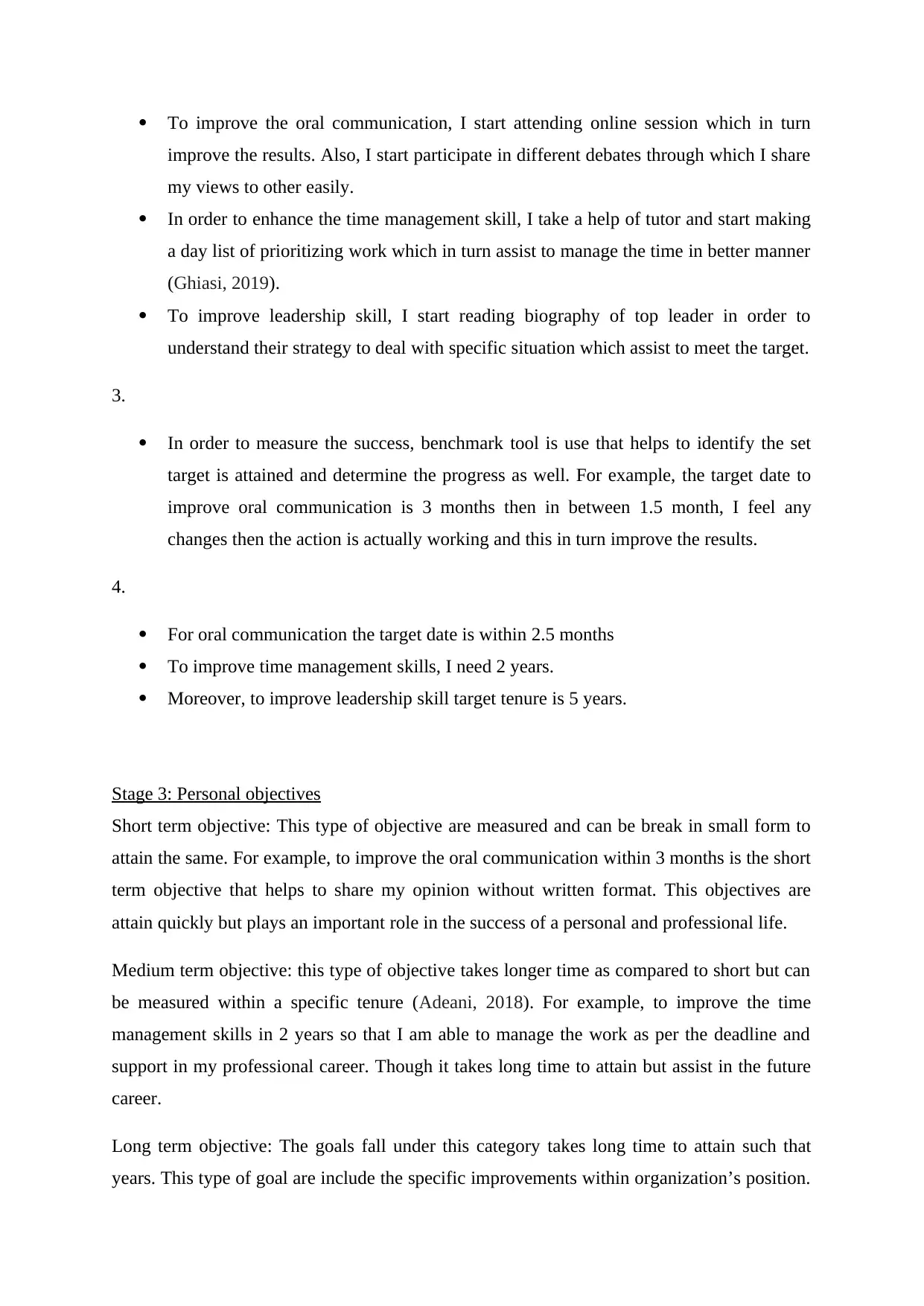
To improve the oral communication, I start attending online session which in turn
improve the results. Also, I start participate in different debates through which I share
my views to other easily.
In order to enhance the time management skill, I take a help of tutor and start making
a day list of prioritizing work which in turn assist to manage the time in better manner
(Ghiasi, 2019).
To improve leadership skill, I start reading biography of top leader in order to
understand their strategy to deal with specific situation which assist to meet the target.
3.
In order to measure the success, benchmark tool is use that helps to identify the set
target is attained and determine the progress as well. For example, the target date to
improve oral communication is 3 months then in between 1.5 month, I feel any
changes then the action is actually working and this in turn improve the results.
4.
For oral communication the target date is within 2.5 months
To improve time management skills, I need 2 years.
Moreover, to improve leadership skill target tenure is 5 years.
Stage 3: Personal objectives
Short term objective: This type of objective are measured and can be break in small form to
attain the same. For example, to improve the oral communication within 3 months is the short
term objective that helps to share my opinion without written format. This objectives are
attain quickly but plays an important role in the success of a personal and professional life.
Medium term objective: this type of objective takes longer time as compared to short but can
be measured within a specific tenure (Adeani, 2018). For example, to improve the time
management skills in 2 years so that I am able to manage the work as per the deadline and
support in my professional career. Though it takes long time to attain but assist in the future
career.
Long term objective: The goals fall under this category takes long time to attain such that
years. This type of goal are include the specific improvements within organization’s position.
improve the results. Also, I start participate in different debates through which I share
my views to other easily.
In order to enhance the time management skill, I take a help of tutor and start making
a day list of prioritizing work which in turn assist to manage the time in better manner
(Ghiasi, 2019).
To improve leadership skill, I start reading biography of top leader in order to
understand their strategy to deal with specific situation which assist to meet the target.
3.
In order to measure the success, benchmark tool is use that helps to identify the set
target is attained and determine the progress as well. For example, the target date to
improve oral communication is 3 months then in between 1.5 month, I feel any
changes then the action is actually working and this in turn improve the results.
4.
For oral communication the target date is within 2.5 months
To improve time management skills, I need 2 years.
Moreover, to improve leadership skill target tenure is 5 years.
Stage 3: Personal objectives
Short term objective: This type of objective are measured and can be break in small form to
attain the same. For example, to improve the oral communication within 3 months is the short
term objective that helps to share my opinion without written format. This objectives are
attain quickly but plays an important role in the success of a personal and professional life.
Medium term objective: this type of objective takes longer time as compared to short but can
be measured within a specific tenure (Adeani, 2018). For example, to improve the time
management skills in 2 years so that I am able to manage the work as per the deadline and
support in my professional career. Though it takes long time to attain but assist in the future
career.
Long term objective: The goals fall under this category takes long time to attain such that
years. This type of goal are include the specific improvements within organization’s position.
Paraphrase This Document
Need a fresh take? Get an instant paraphrase of this document with our AI Paraphraser
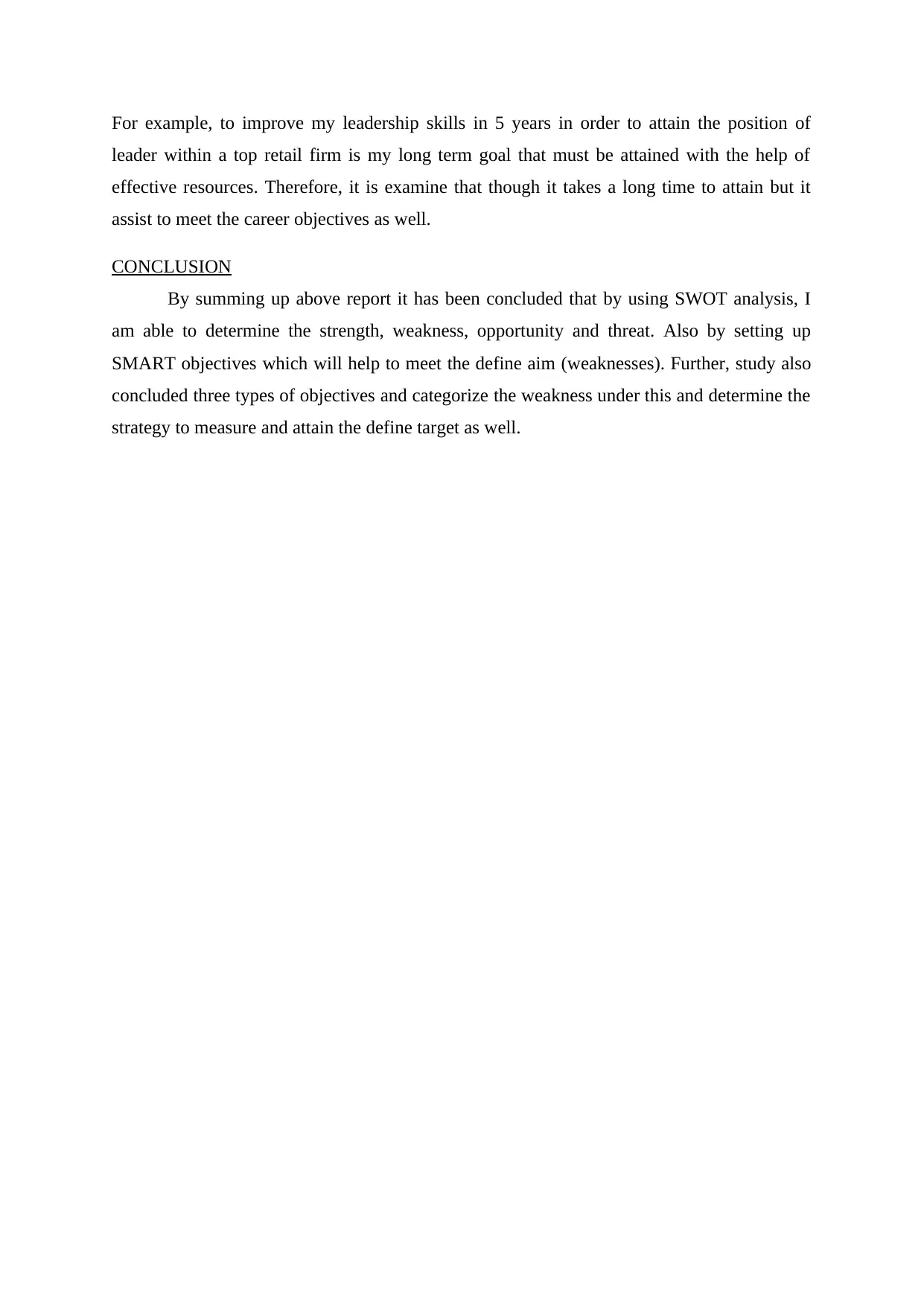
For example, to improve my leadership skills in 5 years in order to attain the position of
leader within a top retail firm is my long term goal that must be attained with the help of
effective resources. Therefore, it is examine that though it takes a long time to attain but it
assist to meet the career objectives as well.
CONCLUSION
By summing up above report it has been concluded that by using SWOT analysis, I
am able to determine the strength, weakness, opportunity and threat. Also by setting up
SMART objectives which will help to meet the define aim (weaknesses). Further, study also
concluded three types of objectives and categorize the weakness under this and determine the
strategy to measure and attain the define target as well.
leader within a top retail firm is my long term goal that must be attained with the help of
effective resources. Therefore, it is examine that though it takes a long time to attain but it
assist to meet the career objectives as well.
CONCLUSION
By summing up above report it has been concluded that by using SWOT analysis, I
am able to determine the strength, weakness, opportunity and threat. Also by setting up
SMART objectives which will help to meet the define aim (weaknesses). Further, study also
concluded three types of objectives and categorize the weakness under this and determine the
strategy to measure and attain the define target as well.
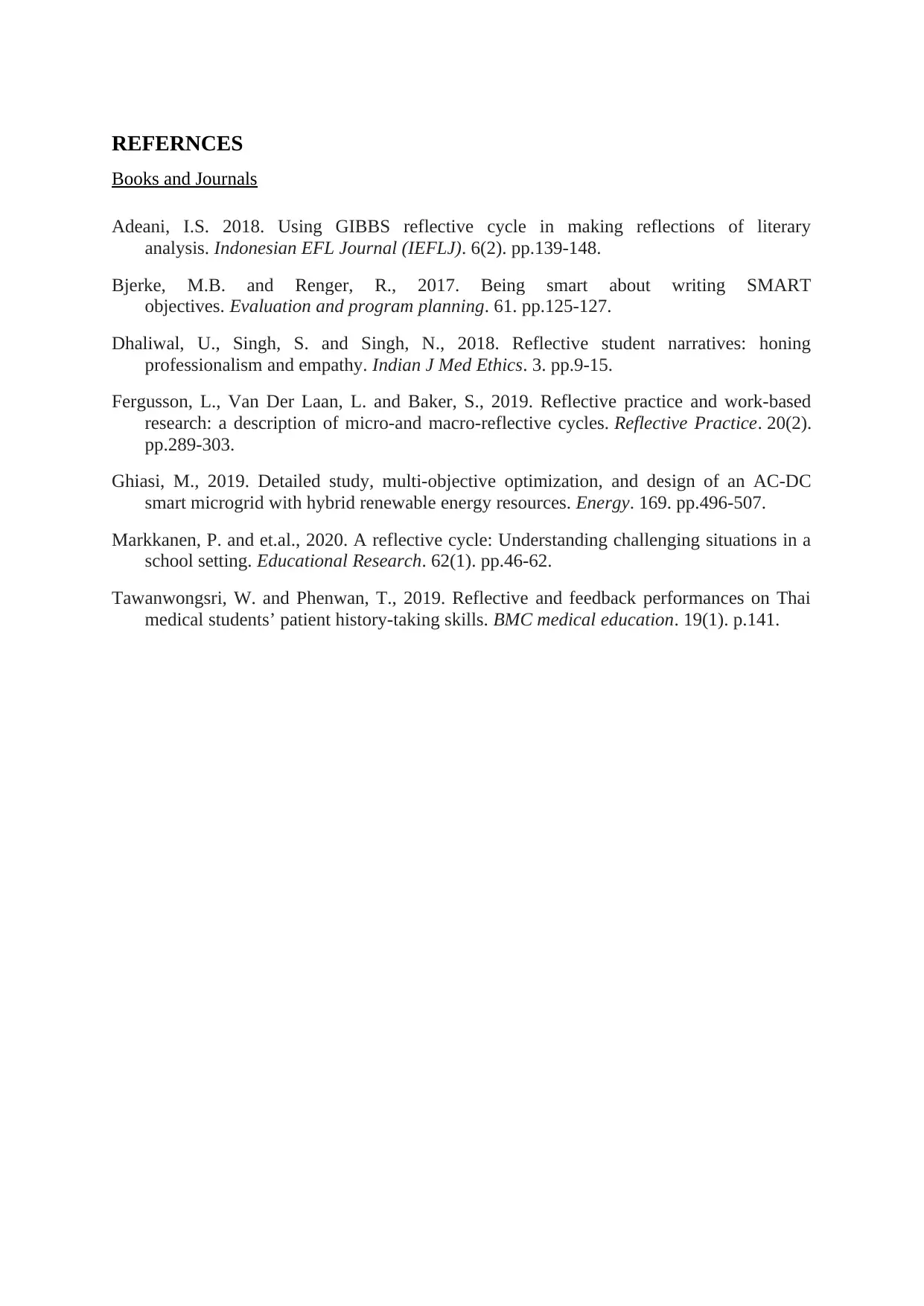
REFERNCES
Books and Journals
Adeani, I.S. 2018. Using GIBBS reflective cycle in making reflections of literary
analysis. Indonesian EFL Journal (IEFLJ). 6(2). pp.139-148.
Bjerke, M.B. and Renger, R., 2017. Being smart about writing SMART
objectives. Evaluation and program planning. 61. pp.125-127.
Dhaliwal, U., Singh, S. and Singh, N., 2018. Reflective student narratives: honing
professionalism and empathy. Indian J Med Ethics. 3. pp.9-15.
Fergusson, L., Van Der Laan, L. and Baker, S., 2019. Reflective practice and work-based
research: a description of micro-and macro-reflective cycles. Reflective Practice. 20(2).
pp.289-303.
Ghiasi, M., 2019. Detailed study, multi-objective optimization, and design of an AC-DC
smart microgrid with hybrid renewable energy resources. Energy. 169. pp.496-507.
Markkanen, P. and et.al., 2020. A reflective cycle: Understanding challenging situations in a
school setting. Educational Research. 62(1). pp.46-62.
Tawanwongsri, W. and Phenwan, T., 2019. Reflective and feedback performances on Thai
medical students’ patient history-taking skills. BMC medical education. 19(1). p.141.
Books and Journals
Adeani, I.S. 2018. Using GIBBS reflective cycle in making reflections of literary
analysis. Indonesian EFL Journal (IEFLJ). 6(2). pp.139-148.
Bjerke, M.B. and Renger, R., 2017. Being smart about writing SMART
objectives. Evaluation and program planning. 61. pp.125-127.
Dhaliwal, U., Singh, S. and Singh, N., 2018. Reflective student narratives: honing
professionalism and empathy. Indian J Med Ethics. 3. pp.9-15.
Fergusson, L., Van Der Laan, L. and Baker, S., 2019. Reflective practice and work-based
research: a description of micro-and macro-reflective cycles. Reflective Practice. 20(2).
pp.289-303.
Ghiasi, M., 2019. Detailed study, multi-objective optimization, and design of an AC-DC
smart microgrid with hybrid renewable energy resources. Energy. 169. pp.496-507.
Markkanen, P. and et.al., 2020. A reflective cycle: Understanding challenging situations in a
school setting. Educational Research. 62(1). pp.46-62.
Tawanwongsri, W. and Phenwan, T., 2019. Reflective and feedback performances on Thai
medical students’ patient history-taking skills. BMC medical education. 19(1). p.141.
⊘ This is a preview!⊘
Do you want full access?
Subscribe today to unlock all pages.

Trusted by 1+ million students worldwide
1 out of 9
Related Documents
Your All-in-One AI-Powered Toolkit for Academic Success.
+13062052269
info@desklib.com
Available 24*7 on WhatsApp / Email
![[object Object]](/_next/static/media/star-bottom.7253800d.svg)
Unlock your academic potential
Copyright © 2020–2025 A2Z Services. All Rights Reserved. Developed and managed by ZUCOL.





